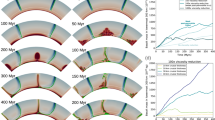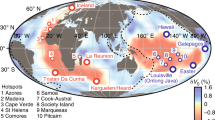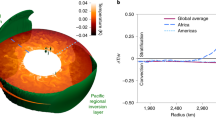Abstract
Recent seismological work has revealed new structures in the boundary layer between the Earth's core and mantle that are altering and expanding perspectives of the role this region plays in both core and mantle dynamics. Clear challenges for future research in seismological, experimental, theoretical and computational geophysics have emerged, holding the key to understanding both this dynamic system and geological phenomena observed at the Earth's surface.
This is a preview of subscription content, access via your institution
Access options
Subscribe to this journal
Receive 51 print issues and online access
$199.00 per year
only $3.90 per issue
Buy this article
- Purchase on Springer Link
- Instant access to full article PDF
Prices may be subject to local taxes which are calculated during checkout






Similar content being viewed by others
References
Lay, T. Structure of the core-mantle transition zone: A chemical and thermal boundary layer. Eos 70, 54–55, 58–59 (1989).
Loper, D. E. & Lay, T. The core-mantle boundary region. J. Geophys. Res. 100, 6397–6420 (1995).
Williams, Q. & Jeanloz, R. Melting relations in the iron-sulfur system at high pressures: Implications for the thermal state of the Earth. J. Geophys. Res. 95, 19299–19310 (1990).
Boehler, R. Temperatures in the Earth's core from melting-point measurements of iron at high static pressures. Nature 363, 534–536 (1993).
Davies, G. F. Ocean bathymetry and mantle convection, 1, Large-scale flow and hotspots. J. Geophys. Res. 93, 10447–10480 (1988).
Sleep, N. H. Hotspots and mantle plumes: Some phenomenology. J. Geophys. Res. 95, 6715–6736 (1990).
Loper, D. E. Mantle plumes. Tectonophysics 187, 373–384 (1991).
Hoffman, A. W. & White, W. M. Mantle plumes from ancient oceanic crust. Earth Planet. Sci. Lett. 57, 421–436 (1982).
Woodhead, J. D., Greenwood, P., Harmon, R. S. & Stoffers, P. Oxygen isotope evidence for recycled crust in the source of EM-type ocean island basalts. Nature 362, 809–813 (1993).
Su, W-J., Woodward, R. & Dziewonski, A. M. Degree 12 model of shear velocity heterogeneity in the mantle. J. Geophys. Res. 99, 6945–6980 (1994).
Li, X. D. & Romanowicz, B. Global mantle shear velocity model developed using nonlinear asymptotic coupling theory. J. Geophys. Res. 101, 22245–22272 (1996).
Masters, T. G., Johnson, S., Laske, G. & Bolton, H. Ashear-velocity model of the mantle. Phil. Trans. R. Soc. Lond. A 354, 1385–1411 (1996).
Gubbins, D. Core-mantle interactions. Tectonophysics 187, 385–391 (1991).
Bloxham, J. & Jackson, A. Fluid flow near the surface of Earth's outer core. Rev. Geophys. 29, 97–120 (1991).
Hide, R., Speith, M. A., Clayton, R. W., Hager, B. H. & Voorhies, C. V. in Relating Geophysical Structures and Processes: The Jeffreys Volume (eds Aki, K. & Dmowska, R.) 107–120 (Geophys. Monogr. Ser. 76, Am. Geophys Union, Washington DC, (1993)).
Knittle, E. & Jeanloz, R. Earth's core-mantle boundary: Results of experiments at high pressures and temperatures. Science 251, 1438–1443 (1991).
Poirier, J.-P. Core-infiltrated mantle and the nature of the D″ layer. J. Geomagn. Geoelectr. 45, 1221–1227 (1993).
Lay, T. Seismology of the lower mantle and core-mantle boundary. Rev. Geophys. Suppl. 325–328 (1995).
Weber, M. et al. in Seismic Modeling of the Earth's Structure (eds Boschi, E., Ekström, G. & Morelli, A.) 399–442 (Istit. Naz. di Geophys., Rome, (1996)).
Ding, X. & Helmberger, D. V. Modeling D″ structure beneath Central America with broadband seismic data. Phys. Earth Planet Inter. 101, 245–270 (1997).
Wysession, M. E. et al. The D″ discontinuity and its implications.in The Core-Mantle Boundary (eds Gurnis, M., Buffett, B. A., Knittle, E. & Wysession, M.) (Am. Geophys. Union, in the press).
Vinnik, L., Romanowicz, B., Le Stunff, Y. & Makeyeva, L. Seismic anisotropy in the D″ layer. Geophys. Res. Lett. 22, 1657–1660 (1995).
Kendall, J.-M. & Silver, P. G. Constraints from seismic anisotropy on the nature of the lowermost mantle. Nature 381, 409–412 (1996).
Matzel, E., Sen, M. K. & Grand, S. P. Evidence for anisotropy in the deep mantle beneath Alaska. Geophys. Res. Lett. 23, 2417–2420 (1996).
Garnero, E. J. & Lay, T. Lateral variations in lowermost mantle shear wave anisotropy beneath the north Pacific and Alaska. J. Geophys. Res. 102, 8121–8135 (1997).
Lay, T., Garnero, E. J., Williams, Q., Kellogg, L. & Wysession, M. E. Seismic wave anisotropy in the D″ region and its implications.in The Core-Mantle Boundary (eds Gurnis, M., Buffett, B. A., Knittle, E. & Wysession, M.) (Am. Geophys. Union, in the press).
Garnero, E. J. & Helmberger, D. V. Avery slow basal layer underlying large-scale low-velocity anomalies in the lower mantle beneath the Pacific: evidence from core phases. Phys. Earth Planet. Inter. 91, 161–176 (1995).
Mori, J. & Helmberger, D. V. Localized boundary layer below the mid-Pacific velocity anomaly identified from a PcP precursor. J. Geophys. Res. 100, 20359–20365 (1995).
Garnero, E. J., Revenaugh, J., Williams, Q., Lay, T. & Kellogg, L. Ultra-low velocity zone at the core-mantle boundary.in The Core-Mantle Boundary (eds Gurnis, M., Buffett, B. A., Knittle, E. & Wysession, M.) (Am Geophys. Union, in the press).
Grand, S. P., van der Hilst, R. D. & Widiyantoro, S. Global seismic tomography: A snapshot of convection in the Earth. GSA Today 7, 1–7 (1997).
van der Hilst, R. D., Widiyantoro, S. & Engdahl, E. R. Evidence for deep mantle circulation from global tomography. Nature 386, 578–584 (1997).
Young, C. J. & Lay, T. The core mantle boundary. Annu. Rev. Earth Planet. Sci. 15, 25–46 (1987).
Wysession, M. E. Large scale structure at the core-mantle boundary from core-diffracted waves. Nature 382, 244–248 (1996).
Lay, T. & Helmberger, D. V. Alower mantle S-wave triplication and the shear velocity structure of D″. Geophys. J. R. Astron. Soc. 75, 799–838 (1983).
Williams, Q. & Garnero, E. J. Seismic evidence for partial melt at the base of Earth's mantle. Science 273, 1528–1530 (1996).
Revenaugh, J. S. & Meyer, R. Seismic evidence of partial melt within a possibly ubiquitous low velocity layer at the base of the mantle. Science 277, 670–673 (1997).
Garnero, E. J. & Helmberger, D. V. Seismic detection of a thin laterally varying boundary layer at the base of the mantle beneath the central-Pacific. Geophys. Res. Lett. 23, 977–980 (1996).
Bataille, K., Wu, R. S. & Flatté, S. M. Inhomogeneities near the core-mantle boundary evidenced from scattered waves: A review. Pure Appl. Geophys. 132, 151–174 (1990).
Vidale, J. E. & Hedlin, M. A. H. Evidence for partial melt at the core–mantle boundary north of Tonga from the strong scattering of seismic waves. Nature 391, 682–685 (1998).
Kaneshima, S. & Silver, P. G. Asearch for source-side anisotropy. Geophys. Res. Lett. 19, 1049–1052 (1992).
Meade, C., Silver, P. G. & Kaneshima, S. Laboratory and seismological observations of lower mantle isotropy. Geophys. Res. Lett. 22, 1293–1296 (1995).
Pulliam, J. & Sen, M. K. Seismic anisotropy in the core-mantle transition zone. Geophys. J. Int. (in the press).
Kendall, J.-M. & Silver, P. G. Investigating causes of D″ anisotropy.in The Core-Mantle Boundary (eds Gurnis, M., Buffett, B. A., Knittle, E. & Wysession, M.) (Am Geophys. Union, in the press).
Ritsema, J., Lay, T., Garnero, E. J. & Benz, H. Seismic anisotropy in the lowermost mantle beneath the Pacific. Geophys. Res. Lett. (in the press).
Weber, M. Pand S wave reflections from anomalies in the lowermost mantle. Geophys. J. Int. 115, 183–210 (1993).
Lay, T., Garnero, E. J., Young, C. J. & Gaherty, J. B. Scale-lengths of shear velocity heterogeneity at the base of the mantle from S wave differential travel times. J. Geophys. Res. 102, 9887–9910 (1997).
Lay, T. & Young, C. J. Analysis of seismic SV waves in the core's penumbra. Geophys. Res. Lett. 18, 1373–1376 (1991).
Kendall, J.-M. & Nangini, C. Lateral variations in D″ below the Caribbean. Geophys. Res. Lett. 23, 399–402 (1996).
Ritsema, J., Garnero, E. & Lay, T. Astrongly negative shear velocity gradient and lateral variability in the lowermost mantle beneath the Pacific. J. Geophys. Res. 102, 20395–20411 (1997).
Stacey, F. D. & Loper, D. E. The thermal boundary layer interpretation of D″ and its role as a plume source. Phys. Earth Planet. Inter. 33, 45–55 (1983).
Backus, G. E. Long-wave elastic anisotropy produced by horizontal layering. J. Geophys. Res. 67, 4427–4440 (1962).
Whitehead, J. A. & Luther, D. S. Dynamics of laboratory diapir and plume models. J. Geophys. Res. 80, 705–717 (1975).
Duncan, R. A. & Richards, M. A. Hotspots, mantle plumes, flood basalts, and true polar wander. Rev. Geophys. 29, 31–50 (1991).
Ribe, N. M. & de Valpine, D. P. The global hotspot distribution and instability of D″. Geophys. Res. Lett. 21, 1507–1510 (1994).
Bercovici, D. & Kelly, A. The non-linear initiation of diapirs and plume heads. Phys. Earth Planet. Inter. 101, 119–130 (1997).
Karato, S. & Li, P. Diffusion creep in perovskite: Implications for the rheology of the lower mantle. Science 255, 1238–1240 (1992).
Williams, Q., Revenaugh, J. & Ganero, E. J. Acorrelation between ultralow basal velocities in the mantle and hotspots. Science (submitted).
Watson, S. & McKenzie, D. P. Melt generation by plumes: A study of Hawaiian volcanism. J. Petrol. 12, 501–537 (1991).
Nataf, H.-C. & vanDecar, J. Seismological detection of a mantle plume? Nature 264, 115–120 (1993).
Farnetani, C. G. & Richards, M. A. Thermal entrainment and melting in mantle plumes. Earth Planet. Sci. Lett. 136, 251–267 (1995).
Leitch, A. M., Steinbach, V. & Yuen, D. A. Centerline temperature of mantle plumes in various geometries: Incompressible flow. J. Geophys. Res. 101, 21928–21846 (1996).
Farnetani, C. G. Excess temperature of mantle plumes: The role of chemical stratification across D″. Geophys. Res. Lett. 24, 1583–1586 (1997).
Walker, R. J., Morgan, J. W. & Horan, M. F. Osmium-187 enrichment in some plumes — evidence for core-mantle interaction. Science 269, 819–822 (1995).
Storey, B. C. The role of mantle plumes in continental breakup — case histories from Gondwanaland. Nature 377, 301–308 (1995).
Sleep, N. H., Richards, M. A. & Hager, B. H. On the onset of mantle plumes in the presence of preexisting convection. J. Geophys. Res. 93, 7672–7689 (1988).
Davies, G. F. & Gurnis, M. Interaction of mantle dregs with convection: lateral heterogeneity at the core-mantle boundary. Geophys. Res. Lett. 13, 1517–1520 (1986).
Sleep, N. H. Gradual entrainment of a chemical layer at the base of the mantle by overlying convection. Geophys. J. 95, 437–447 (1988).
Goarant, F., Guyot, F., Peyronneau, J. & Poirier, J. P. High pressure and high-temperature reactions between silicates and liquid iron alloys, in the diamond anvil cell, studied by analytical electron microscopy. J. Geophys. Res. 97, 4477–4487 (1992).
Song, Y. & Ahrens, T. J. Pressure-temperature range of reactions between liquid iron in the outer core and mantle silicates. Geophys. Res. Lett. 21, 153–156 (1994).
Ito, E., Morooka, K., Ujike, O. & Katsura, T. Reactions between molten iron and silicate melts at high pressure: Implications for the chemical evolution of Earth's core. J. Geophys. Res. 100, 5901–5910 (1995).
Manga, M. & Jeanloz, R. Implications of a metal-bearing chemical boundary layer in D″ for mantle dynamics. Geophys. Res. Lett. 23, 3091–3094 (1996).
Rigden, S. M., Ahrens, T. J. & Stolper, E. M. High-pressure equation of state of molten anorthite and diopside. J. Geophys. Res. 94, 9508–9522 (1989).
McFarlane, E., Drake, M. J. & Rubie, D. C. Element partitioning between Mg-perovskite, magnesiowüstite and silicate melt at conditions of the Earth's mantle. Geochim. Cosmochim. Acta 58, 5161–5172 (1994).
Ohtani, E., Kato, T. & Ito, E. Transition metal partitioning between lower mantle and core materials. Geophys. Res. Lett. 18, 85–88 (1991).
Duffy, T. & Ahrens, T. J. in High-Pressure Research: Application to Earth and Planetary Sciences (eds Syono, Y. & Manghnani, M. H.) 197–205 (Terra Scientific, Tokyo, (1992)).
Knittle, E. The solid/liquid partitioning of major and radiogenic elements at lower mantle pressures: Implications for the core-mantle boundary region.in The Core-Mantle Boundary (eds Gurnis, M., Buffett, B. A., Knittle, E. & Wysession, M.) (Am Geophys. Union, in the press).
Holland, K. G. & Ahrens, T. J. Melting of (Mg, Fe)2SiO4at the core-mantle boundary of the Earth. Science 275, 1623–1625 (1997).
Crough, S. T. & Jurdy, D. M. Subducted lithosphere, hot spots and the geoid. Earth Planet. Sci. Lett. 48, 15–22 (1980).
Karato, S. I., Zhang, S. & Wenk, H. R. Superplasticity in Earth's lower mantle: Evidence from seismic anisotropy and rock physics. Science 270, 458–461 (1995).
Frost, H. J. & Ashby, M. F. Deformation Mechanism Maps (Pergamon, Oxford, (1982)).
Cohen, R. E. in High-Pressure Research: Application to Earth and Planetary Sciences (eds Syono, Y. & Manghnani, M. H.) 425–431 (Terra Scientific, Tokyo, (1992)).
Stewart, D. N., Buse, F. H., Walker, K. A. & Gubbins, D. Geomagnetism, Earth rotation and the electrical conductivity of the lower mantle. Phys. Earth Planet. Inter. 92, 199–214 (1995).
Larson, R. L. & Olson, P. Mantle plumes control magnetic reversal frequency. Earth Planet Sci. Lett. 107, 437–447 (1991).
Marzocchi, W. & Mulargia, F. The periodicity of geomagnetic reversals. Phys. Earth Planet. Inter. 73, 222–228 (1992).
Laj, C., Mazaud, A., Weeks, R., Fuller, M. & Herrero-Bervverra, E. Geomagnetic reversal paths. Nature 351, 447–450 (1991).
Valet, J. P., Tucholka, P., Courtillot, V. & Meynadier, L. Palaeomagnetic constraints on the geometry of the geomagnetic field during reversals. Nature 356, 400–407 (1992).
Hoffman, K. Dipolar reversal states of the geomagnetic field and core-mantle dynamics. Nature 359, 789–794 (1992).
Aurnou, J. M., Buttles, J. L., Neumann, G. A. & Olson, P. L. Electromagnetic core-mantle coupling and paleomagnetic reversal paths. Geophys. Res. Lett. 23, 2705–2708 (1996).
Courtillot, V. & Valet, J. P. Secular variation of the Earth's magnetic field: From jerks to reversals. C. R. Acad. Sci. 320, 903–922 (1995).
Shankland, T. J., Peyronneau, J. & Poirier, J. P. Electrical conductivity of the Earth's lower mantle. Nature 366, 453–455 (1993).
Li, X. & Jeanloz, R. Laboratory studies of the electrical conductivity of silicate perovskites at high pressures and temperatures. J. Geophys. Res. 95, 5067–5078 (1990).
Tonks, W. B. & Melosh, H. J. in Origin of the Earth (eds Newsom, H. E. & Jones, J. H.) 151–174 (Oxford Univ. Press, New York, (1990)).
Birch, F. Elasticity and constitution of the Earth's interior. J. Geophys. Res. 57, 227–286 (1952).
Lithgow-Bertelloni, C. & Richards, M. A. The dynamics of Cenozoic and Mesozoic plate motions. Annu. Rev. Earth Planet. Sci. (in the press).
Acknowledgements
We thank C. Lithgow-Bertelloni, R. van der Hilst and S. Grand for providing access to their models and M. Kendall for providing comments on the manuscript. This work was supported by the US National Science Foundation.
Author information
Authors and Affiliations
Corresponding author
Rights and permissions
About this article
Cite this article
Lay, T., Williams, Q. & Garnero, E. The core–mantle boundary layer and deep Earth dynamics. Nature 392, 461–468 (1998). https://doi.org/10.1038/33083
Issue Date:
DOI: https://doi.org/10.1038/33083
This article is cited by
-
Scanning for planetary cores with single-receiver intersource correlations
Nature Astronomy (2022)
-
A model for the geomagnetic field reversal rate and constraints on the heat flux variations at the core-mantle boundary
Scientific Reports (2020)
-
Elasticity and Anisotropy of the Pyrite-Type FeO2H-FeO2 System in Earth’s Lowermost Mantle
Journal of Earth Science (2019)
-
Multi-precursory Analysis of Phalla Earthquake (July 2015; Mw 5.1) Near Islamabad, Pakistan
Pure and Applied Geophysics (2018)
-
Modeling defects and plasticity in MgSiO3 post-perovskite: Part 3—Screw and edge [001] dislocations
Physics and Chemistry of Minerals (2017)
Comments
By submitting a comment you agree to abide by our Terms and Community Guidelines. If you find something abusive or that does not comply with our terms or guidelines please flag it as inappropriate.



